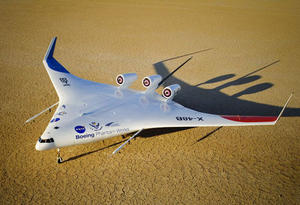AviaionFuturistic blended wing body aircraft passes flight test
Boeing took another step forward in exploring a revolutionary concept — the blended wing body (BWB) — which one day could offer breakthroughs in flight; the X-48B, an unmanned research aircraft which is a scale model of a heavy-lift, subsonic vehicle that forgoes the conventional tube-and-wing airplane design in favor of a triangular aircraft that effectively merges the vehicle’s wing and body, proved during a flight test program that a BWB aircraft can be controlled as effectively as a conventional tube-and-wing aircraft during takeoffs and landings, as well as in other low-speed segments of the flight regime

The X-48B, precursor to Boeing's scaled-down X-48C // Source: boeing.com
Boeing took another step forward in exploring revolutionary concepts which one day could offer breakthroughs in flight.
The remotely piloted X-48C aircraft took off at 7:56 a.m. Pacific Time on 7 August from NASA’s Dryden Flight Research Center at Edwards Air Force Base in California. The vehicle climbed to an altitude of 5,500 feet before landing nine minutes later.
Boeing says that the X-48C is a scale model of a heavy-lift, subsonic vehicle that forgoes the conventional tube-and-wing airplane design in favor of a triangular aircraft that effectively merges the vehicle’s wing and body. Boeing and NASA believe the blended wing body ( BWB) concept offers the potential over the long-term of significantly greater fuel efficiency and reduced noise.
With a 21-foot wingspan and a weight of 500 pounds, the X-48C is a modified version of the X-48B aircraft, which flew ninety-two times at NASA Dryden between 2007 and 2010. The X-48C is configured with two 89-pound thrust turbojet engines, instead of three 50-pound thrust engines on the B-model; and wingtip winglets have been relocated inboard next to the engines on the C-model, effectively turning them into twin tails. The aft deck also was extended about two feet at the rear. The vehicle has an estimated top speed of about 140 miles per hour and a maximum altitude of 10,000 feet.
The X-48B’s flight test program proved that a BWB aircraft can be controlled as effectively as a conventional tube-and-wing aircraft during takeoffs and landings, as well as in other low-speed segments of the flight regime. “With the X-48C, we will be evaluating the impact of noise shielding concepts on low-speed flight characteristics,” said Bob Liebeck, a Boeing senior technical fellow and the company’s BWB program manager.
The X-48C is an 8.5 percent scale model of an aircraft with a 240-foot wingspan that possibly could be developed in the next 15 to 20 years for military applications such as aerial refueling and cargo missions. The X-48C project team consists of Boeing, NASA, Cranfield Aeropace, and the U.S. Air Force Research Laboratory.
